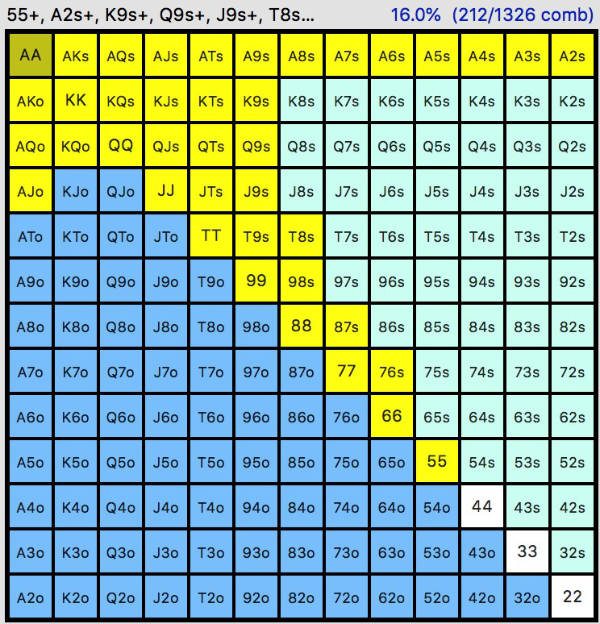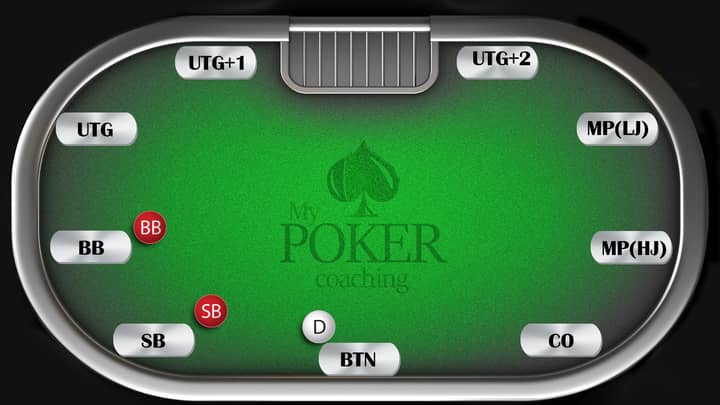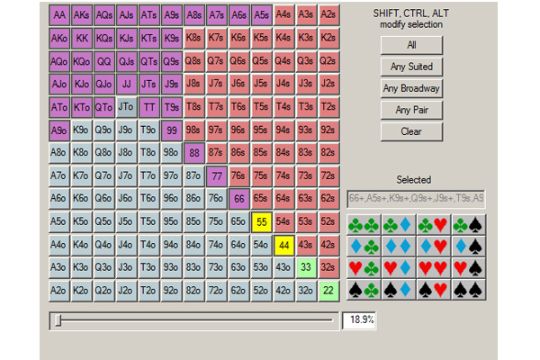Poker Range relates to a set of hands that either you or an opponent might hold in a particular situation. So, instead of thinking of one holding like J♣10♦, you would include several hands in a range. For example – K9s, Q9s, J9s, etc. – is part of a poker range of hands. This concept is what we call a range in poker. How many Poker Hands are there? There are only 10 distinct poker hand ranks, but if you randomly deal 5 cards from a deck of 52 cards there are exactly 2,598,960 possible card combinations. Poker Hand Odds for 5-Card-Poker. The poker hand ranking charts are based on the probability for each distinct hand rank.
By Alton Hardin
Introduction
We utilize the concept of hand ranges when we are trying to determine what possible hands our opponents can have in any particular poker hand. The reason that we use ranges is because it is much easier to put our opponents on a range of hands rather than on a particular hand. Why is that? Because poker players do certain things in poker, such as pre-flop raises, isolation raises, squeeze plays, 3-bets, 4-bets, steals, and so forth with specific ranges of hands that we can estimate based upon their HUD stats.
Understanding and being able to visualize hand ranges is an important skill set to have in poker because many HUD stats align closely with hand ranges. Additionally, understanding hand ranges is very important when attempting to read your opponents' hands and put them on a range of possible hands.
What are hand ranges?
Hand ranges are the overall range of hands that a person can play ranging from a 0% range to a 100% range. In Texas Holdem, there are a total of 1,326 hand combinations for a 100% range. In this article we will use PokerStrategy.com's free Equilab software to help us visualize hand ranges.
I recommend that you download this free software application and utilize it. You can easily find instruction tutorials on how to use it online. It is invaluable, especially for pot equity calculations.
Visualizing 100% Range
Below is a visualization of all the possible two-card combinations in Texas Holdem, which equates into 1,326 hand combinations. For each pair, there are a total of 6 combinations and each non-pair hand there are a total of 16 combinations. Let's do some quick math to show you how we get 1,326 hand combinations:
- 78 Non-Pair 2 Card Hands x 16 Combos
- 1,248 Hand Combos
- 13 Pair 2 Card Hands x 6 Combos
- 78 Hand Combos
- Total Hand Combos = 1,326 Hand Combos
Visualizing a 9% Range
A 9% opening range is fairly conservative UTG pre-flop opening range. With Equilab, we can easily visualize this range, which would be 66+, ATs+, KQs, AJo+, KQo.
Visualizing a 45% Range
A bad, loose passive calling station will typically have a VPIP of around 45%. Let's take a look at a 45% range to get an idea of how many hands are in that range. As you can see in the image below, that is a lot of hand combinations! That is why bad players miss the flop so often and end up having to fold on the flop so often. This is why it is so profitable to play against bad, loose passive poker players.
Relating Hand Ranges to HUD Stats
Now that you have an idea of what hand ranges are and you know how to visualize them with Equilab, let's relate hand ranges to HUD stats. Remember that HUD stats are displayed as percentages, so we can look at particular HUD stats and correlate those to estimated hand ranges.
VPIP and PFR Example
For example, let's take a look at a player's VPIP and PFR. Let's hypothetically say a player has a VPIP of 45% and a PFR of 9%. In a HUD this is usually shown as VPIP 45/PFR 9 or 45/9. So if someone tells you villain was a 45/9, they are referring to your opponent's VPIP/PFR HUD stats.
Expansion slots peripheral devices. What this is telling us is that this player is voluntarily putting money into the pot pre-flop with approximately 45% of all possible hand ranges; moreover, he is raises pre-flop with approximately the top 9% of all possible hand ranges. So majority of the time, he is limping in pre-flop and a small percentage of the time he is raising.
We already visualized a 45% and 9% hand range previously in this chapter, so we know that this player's ranges look something like this (using Equilab):
- 45% VPIP: 44+, A2s+, K2s+, Q4s+, J6s+, T6s+, 96s+, 86s+, 76s, A2o+, K6o+, Q8o+, J8o+, T8o+, 98o
- 9% PFR: 66+, AJs+, KQs, AJo+, KQo
We now know that this player is playing with a huge range of cards pre-flop, but when he is raising we know his range looks something like the estimated 9% PFR listed above. When he is limping, we know he has the other mediocre / implied odds hands in his 45% VPIP range that we can attack, but whenever he raises pre-flop we should be cautious and understand this means he has a strong starting hand.
Other HUD Stats
We can also correlate hand ranges to other basic HUD stats. A player's 3BET and STL stats directly correlate to hand ranges. So, whenever you are looking at VPIP, PFR, 3BET, and STL HUD stats do your best to use those numbers and Equilab to estimate hand ranges for your opponents. If you are new to HUD stats and hand ranges, it is good to have Equilab open while you are playing so you can quickly plug in the numbers, but over time this process will be second nature and you'll be able to rough-guess estimate hand ranges in your head.

Summing Up
This article is a gentle introduction into hand ranges. Understanding the concept of hand ranges is vitally important to becoming a good hand reader. Once we understand hand ranges, we can then dive into the art of hand reading our opponents' range of hands they may play in different situations. If you are interested in learning more about developing poker reads, please check out my Fundamentals of Exploitative Online Poker: Learn to Exploit Your Opponents Through HUD Stats, Player Tendencies and Table Selectionbookavailable at Amazon.com.

Have you ever found yourself mid-game staring at your HUD while facing an open from a player with an RFI stat of 21% and thought to yourself, 'What hands are in his range?' Or while playing live, have you estimated that your opponent calls an open 40% of the time but didn't know what hands comprise that range?
Well, I'll show you the easy way to learn poker ranges for quick reference in the future.
First, here's a Poker Range Chromatic I created for my own use:
I wanted to learn where each hand falls within a range and the above is what I came up with. I used Flopzilla to figure out which hands fall within each percentage grouping. I just started with a 5% range, then went by 5's up to 40%, then followed that with 10's up through 60% then 75%. I used color coding to help visualize the ranges.

I then took the following steps to learn the ranges:

- Printed the chromatic I made, laminated and posted it on the side of my computer monitor for quick in-game reference.
- Created 11 flash cards for use each night as part of my warm-up, and I put the following on them:
- For one week during my study session I would do a hand history review from the previous night's session and each time I faced an open I looked at their RFI Stat in that position and determined what range it fell under. I would say aloud, '20% in the CO… that's 22+, A7s+, ATo+, K9s+, KTo+, Q9s, QTo+, JTo and 98s+.' That's all there was to it. After that first week I got them all down. This is especially helpful when playing live as I can't glance to the side of my screen to get an estimate on an opp's range. Now, it's easier to remember the bottom of the ranges as you're trying to learn these. So, when thinking about 20%, the bottoms are 33, A7s, ATo, Q9s, JTo and 98s. If you just remember those 6 hands for 20%, you know it includes everything better than those. So if the question arises for a hand like K8s, you know that K9s is the bottom at 25% and K7s is the bottom of 30%, so it's within the 30% range and just under the 25% range.
Please let me know if you would make tweaks to these ranges as I always love feedback.

Summing Up
This article is a gentle introduction into hand ranges. Understanding the concept of hand ranges is vitally important to becoming a good hand reader. Once we understand hand ranges, we can then dive into the art of hand reading our opponents' range of hands they may play in different situations. If you are interested in learning more about developing poker reads, please check out my Fundamentals of Exploitative Online Poker: Learn to Exploit Your Opponents Through HUD Stats, Player Tendencies and Table Selectionbookavailable at Amazon.com.
Have you ever found yourself mid-game staring at your HUD while facing an open from a player with an RFI stat of 21% and thought to yourself, 'What hands are in his range?' Or while playing live, have you estimated that your opponent calls an open 40% of the time but didn't know what hands comprise that range?
Well, I'll show you the easy way to learn poker ranges for quick reference in the future.
First, here's a Poker Range Chromatic I created for my own use:
I wanted to learn where each hand falls within a range and the above is what I came up with. I used Flopzilla to figure out which hands fall within each percentage grouping. I just started with a 5% range, then went by 5's up to 40%, then followed that with 10's up through 60% then 75%. I used color coding to help visualize the ranges.
I then took the following steps to learn the ranges:
- Printed the chromatic I made, laminated and posted it on the side of my computer monitor for quick in-game reference.
- Created 11 flash cards for use each night as part of my warm-up, and I put the following on them:
- For one week during my study session I would do a hand history review from the previous night's session and each time I faced an open I looked at their RFI Stat in that position and determined what range it fell under. I would say aloud, '20% in the CO… that's 22+, A7s+, ATo+, K9s+, KTo+, Q9s, QTo+, JTo and 98s+.' That's all there was to it. After that first week I got them all down. This is especially helpful when playing live as I can't glance to the side of my screen to get an estimate on an opp's range. Now, it's easier to remember the bottom of the ranges as you're trying to learn these. So, when thinking about 20%, the bottoms are 33, A7s, ATo, Q9s, JTo and 98s. If you just remember those 6 hands for 20%, you know it includes everything better than those. So if the question arises for a hand like K8s, you know that K9s is the bottom at 25% and K7s is the bottom of 30%, so it's within the 30% range and just under the 25% range.
Please let me know if you would make tweaks to these ranges as I always love feedback.
Poker Hand Ranges Explained Symbols
Study hard and make your next session the best one yet!
Poker Hand Ranges Explained Chart
- The 12 Days of Christmas 2020 Podcast Episodes - December 14, 2020
- Strategies and Action Steps from the Quick Wins Poker Course - November 24, 2020
- How to Quickly Understand Online Tournament Players – Podcast #318 - November 18, 2020